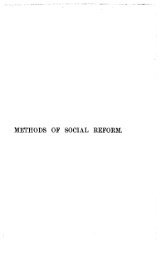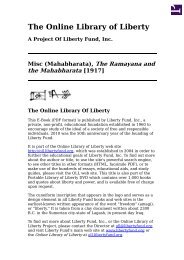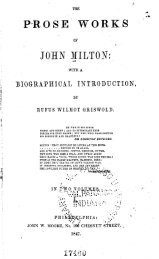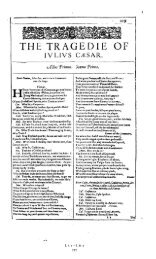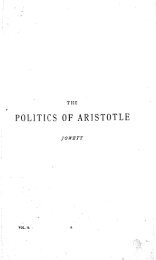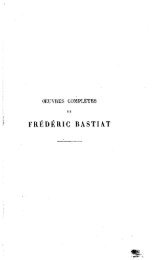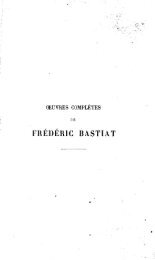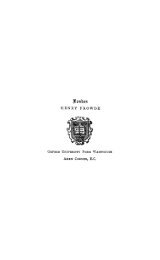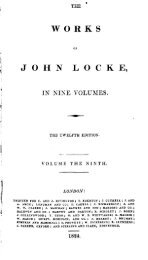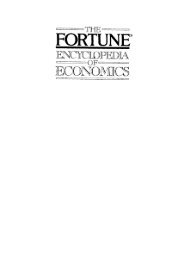- Page 1 and 2:
THE "SUMMA THEOLOGICA"
- Page 3 and 4:
THE "SUMMA THEOLOGICA" OF ST. THOMA
- Page 5 and 6:
1749 .T5 1920 v.4 LETTER FROM THE C
- Page 7 and 8:
CONTENTS TREATISE ON MAN QUESTION P
- Page 9:
TREATISE ON MAN x. 4 J
- Page 12 and 13:
Q. 75. Am'. t THE " SUMMA THEOLOGIC
- Page 14 and 15:
Q. 75. ARt. 2 THE " SUMMA THEOLOGIC
- Page 16 and 17:
9. 75. ART.2 THE " SUMMA THEOLOGICA
- Page 18 and 19:
Q. 75. AR_. 3 THE " SUMMA THEOLOGIC
- Page 20 and 21:
Q. 75. ART.4 THE " SUMMA THEOLOGICA
- Page 22 and 23:
Q. 75. ART.5 THE " SUMMA THEOLOGICA
- Page 24 and 25:
Q.75. Arr. 6 THE " SUMMA THEOLOGICA
- Page 26 and 27:
Q. 75. ART.6 THE " SUMMA THEOLOGICA
- Page 28 and 29:
Q. 75. ART. 7 THE " SUMMA THEOLOGIC
- Page 30 and 31:
QUESTION LXXVI. OF THE UNION OF BOD
- Page 32 and 33:
Q. 76. ART.X THE "SUMMA THEOLOGICA"
- Page 34 and 35:
Q. 76. ART. ! THE " SUMMA THEOLOGIC
- Page 36 and 37:
Q. 76. ART.X THE " SUMMA THEOLOGICA
- Page 38 and 39:
Q. 76. ART. _ THE " SUMMA THEOLOGIC
- Page 40 and 41:
Q. 76. ART. 2 THE " SUMMA THEOLOGIC
- Page 42 and 43:
Q. 76. ART.3 THE " SUMMA .THEOLOGIC
- Page 44 and 45:
Q. 76. Aar.3 THE " SUMMA THEOLOGICA
- Page 46 and 47:
Q. 76. ART.3 THE " SUMMA THEOLOGICA
- Page 48 and 49:
Q. _. ART.4 THE " SUMMA THEOLOGICA
- Page 50 and 51:
Q. 76. ART. 4 THE " SUMMA THEOLOGIC
- Page 52 and 53:
Q. 76. ART.5 THE " SUMMA THEOLOGICA
- Page 54 and 55:
Q. 76. ART.6 THE " SUMMA THEOLOGICA
- Page 56 and 57:
Q. 76. ART.7 THE " SUMMA THEOLOGICA
- Page 58 and 59:
Q. 76. ART.8 THE " SUMMA THEOLOGICA
- Page 60 and 61:
Q. 76. ART.8 THE " SUMMA THEOLOGICA
- Page 62 and 63:
9. 76. A_r. 8 THE " SUMMA THEOLOGIC
- Page 64 and 65:
Q. 77. ARt. x THE " SUMMA THEOLOGIC
- Page 66 and 67:
Q. 77. ART.i THE " SUMMA THEOLOGICA
- Page 68 and 69:
Q. 77. ART.2 THE " SUMMA THEOLOGICA
- Page 70 and 71:
Q. 77.ART.3 THE "SUMMA THEOLOGICA"
- Page 72 and 73:
Q.77. Art. 4 THE " SUMMA THEOLOGICA
- Page 74 and 75:
Q. 77. An. 5 THE " SUMMA THEOLOGICA
- Page 76 and 77:
Q. 77. Agr. 6 THE " SUMMA THEOLOGIC
- Page 78 and 79:
Q. 77. A_. 7 THE "SUMMA THEOLOGICA"
- Page 80 and 81:
Q. 77. ARt. 8 THE " SUMMA THEOLOG1C
- Page 82 and 83:
Q. 77. _urr.8 "ITHE '° SUMMA THEOL
- Page 84 and 85:
Q. 78. ARt. i THE "SUMMA THEOLOGICA
- Page 86 and 87:
9. 78. A_. x THE "SUMMA THEOLOGIGA"
- Page 88 and 89:
Q. 78. A_. 2 THE "SUMMA THEOLOGICA"
- Page 90 and 91:
Q. 78. ART.3 THE " SUMMA THEOLOGICA
- Page 92 and 93:
Q.78. Art. 3 THE " SUMMA THEOLOGICA
- Page 94 and 95:
Q. 78. A,_T.4 THE " SUMMA THEOLOGIC
- Page 96 and 97:
Q.78. A_r. 4 THE " SUMMA THEOLOGICA
- Page 98 and 99:
Q. 78. A_T. 4 THE "SUMMA THEOLOGICA
- Page 100 and 101:
Q. 79. ART. I THE " SUMMA THEOLOGIC
- Page 102 and 103:
Q. 79. ART._' THE " SUMMA THEOLOGIC
- Page 104 and 105:
Q. 79. An. 3 THE "SUMMA THEOLOGICA"
- Page 106 and 107:
Q.79.Awr.4 THE " SUMMA THEOLOGICA "
- Page 108 and 109:
Q. 79- ART.4 THE " SUMMA THEOLOGICA
- Page 110 and 111:
Q. 79, Aar. 5 THE " SUMMA THEOLOGIC
- Page 112 and 113:
Q. 79. Am'. 6 THE " SUMMA THEOLOGIC
- Page 114 and 115:
Q. 7_ ART.6 THE "SUMMA THEOLOGICA"
- Page 116 and 117:
Q. 79. ART.7 THE " SUMMA THEOLOGICA
- Page 118 and 119:
Q. 79. An'r.8 THE "SUMMA THEOLOGICA
- Page 120 and 121:
Q. 79. Asa'.9 THE " SUMMA THEOLOGIC
- Page 122 and 123:
Q. 7_Alrr. xo THE "SUMMA THEOLOGICA
- Page 124 and 125:
Q. 7_ A_r. tt THE " SUMMA THEOLOGIC
- Page 126 and 127:
Q. 79' ART.12 THE " SUMMA THEOLOGIC
- Page 128 and 129:
Q. 79. Am..x3 THE "SUMMA THEOLOGICA
- Page 130 and 131:
QUESTION LXXX. OF THE APPETITIVE PO
- Page 132 and 133:
Q. 80. A_r. 2 THE "SUMMA THEOLOGICA
- Page 134 and 135:
Q. 8o. ART.Z THE "SUMMA THEOLOGICA
- Page 136 and 137:
Q. 8L A_. z THE " SUMMA THEOLOGICA
- Page 138 and 139:
Q. 8i. Amr. 2 THE " SUMMA THEOLOGIC
- Page 140 and 141:
Q. St. AsT. 3 THE " SUMMA THEOLOGIC
- Page 142 and 143:
O. 81. ART.3 THE " SUMMA THEOLOGICA
- Page 144 and 145:
Q. 8_. Am". _ THE " SUMMA THEOLOGIC
- Page 146 and 147:
Q. 82. a_r. 2 THE " SUMMA THEOLOGIC
- Page 148 and 149:
Q. 82. ART. 3 THE " SUMMA THEOLOGIC
- Page 150 and 151:
Q. 82. Amr. 4 THE " SUMMA THEOLOGIC
- Page 152 and 153:
Q. 82. A_rr.5 THE " SUMMA THEOLOGIC
- Page 154 and 155:
Q. 82. ART.5 THE " SUMMA THEOLOGICA
- Page 156 and 157:
Q. 83. ART. ! THE " SUMMA THEOLOGIC
- Page 158 and 159:
Q. 83. ART. 2 THE " SUMMA THEOLOGIC
- Page 160 and 161:
Q. 83. Am-. 3 THE " SUMMA THEOLOGIC
- Page 162 and 163:
Q. 83. ART.4 THE " SUMMA THEOLOGICA
- Page 164 and 165:
QUESTION LXXXIV. HOW THE SOUL WHILE
- Page 166 and 167:
Q.84.A_. t THE " SUMMA THEOLOGICA "
- Page 168 and 169:
Q. 84. A_. a THE '° SUMMA THEOLOGI
- Page 170 and 171:
Q. 84. ART.2 THE " SUMMA THEOLOGICA
- Page 172 and 173:
Q. 84. ART.3 THE " SUMMA THEOLOGICA
- Page 174 and 175:
Q. 84- A_T.4 THE " SUMMA THEOLOGICA
- Page 176 and 177:
Q. 84.ART.4 THE " SUMMA THEOLOGICA
- Page 178 and 179:
Q. 84.Am-.5 THE "SUMMA THEOLOGICA "
- Page 180 and 181:
Q. 84. ARr. 5 THE " SUMMA THEOLOGIC
- Page 182 and 183:
Q"_4' ART. 6 THE " SUMMA THEOLOGICA
- Page 184 and 185:
Q. 84. Am-. 6 THE " SUMMA THEOLOGIC
- Page 186 and 187:
Q. 84. ART. 7 THE " SUMMA THEOLOGIC
- Page 188 and 189:
Q. 84. h_. 8 THE "SUMMA THEOLOGICA"
- Page 190 and 191:
QUESTION LXXXV. OF THE MODE AND ORD
- Page 192 and 193:
Q. 85. Am'. x THE "SUMMA THEOLOGICA
- Page 194 and 195:
Q. 85. Am'. x THE " SUMMA THEOLOGIC
- Page 196 and 197:
Q. 85. AR'r. 2 THE " SUMMA THEOLOGI
- Page 198 and 199:
Q. 85. ART. 2 THE " SUMMA THEOLOGIC
- Page 200 and 201:
Q. 85. Aa-r. 3 THE " SUMMA THEOLOGI
- Page 202 and 203:
Q. 85.ART.3 THE '° SUMMA THEOLOGIC
- Page 204 and 205:
Q.85. Ajar.4 THE " SUMMA THEOLOGICA
- Page 206 and 207:
Q. 85.ARt. 5 THE "SUMMA THEOLOGICA"
- Page 208 and 209:
Q. aS. AzT. 6 THE " SUMMA THEOLOGIC
- Page 210 and 211:
Q. 85. Am'. 7 THE " SUMMA THEOLOGIC
- Page 212 and 213:
Q. 85. An. 8 THE " SUMMA THEOLOGICA
- Page 214 and 215:
Q. 8S. A_. 8_ THE " SUMMA THEOLOGIC
- Page 216 and 217:
Q. 86. ART. I THE "SUMMA THEOLOGICA
- Page 218 and 219:
0.86. A_. • THE " SUMMA THEOLOGIC
- Page 220 and 221:
Q- 86. Arc. 3 THE " SUMMA THEOLOGIC
- Page 222 and 223:
0. 86. AaT. 4 THE " SUMMA THEOLOGIC
- Page 224 and 225:
QUESTION LXXXVII. HOW THE INTELLECT
- Page 226 and 227:
Q. 87. A,T._ THE " SUMMA THEOLOGICA
- Page 228 and 229:
Q. 87.ART.2 THE " SUMMA THEOLOGICA
- Page 230 and 231:
Q. 87. ART.3 THE " SUMMA THEOLOGICA
- Page 232 and 233:
Q. 87. ART.4 THE " SUMMA THEOLOGICA
- Page 234 and 235:
QUESTION LXXXVIII. HOW THE HUMAN SO
- Page 236 and 237:
Q 88. ART.t THE " SUMMA THEOLOGICA"
- Page 238 and 239:
0. 88. ART. x THE " SUMMA THEOLOGIC
- Page 240 and 241:
O. 8a. ART.2 THE " SUMMA THEOLOGICA
- Page 242 and 243:
O. s8. _,rr. 3 THE " SUMMA THEOLOGI
- Page 244 and 245:
QUESTION LXXXIX. OF THE KNOWLEDGE O
- Page 246 and 247:
Q. 89. AItT.t THE " SUMMA THEOLOGIC
- Page 248 and 249:
Q. 89. ART.a THE " SUMMA THEOLOGICA
- Page 250 and 251:
Q. 89. ART. 3 THE " SUMMA THEOLOGIC
- Page 252 and 253: Q. 89. XttT.4 THE " SUMMA THEOLOGIC
- Page 254 and 255: Q. 89. Aar. S THE " SUMMA THEOLOGIC
- Page 256 and 257: _. 89. Arr. 6 THE " SUMMA THEOLOGIC
- Page 258 and 259: Q. 89. A_r. 7 THE " SUMMA THEOLOGIC
- Page 260 and 261: Q. _._z. 8 THE " SUMMA THEOLOGICA"
- Page 262 and 263: QUESTION XC. OF THE F1RST PRODUCTIO
- Page 264 and 265: _. 90_ ART. 2 THE " SUMMA THEOLOGIC
- Page 266 and 267: Q. 9o. A_,. 3 THE " SUMMA THEOLOGIC
- Page 268 and 269: Q. 9o. ART.4 THE " SUMMA THEOLOGICA
- Page 270 and 271: QUESTION XCI. THE PRODUCTION OF THE
- Page 272 and 273: Q. 91. Air. i THE " SUMMA THEOLOGIC
- Page 274 and 275: Q. 9t. ^,r. 2 THE " SUMMA THEOLOGIC
- Page 276 and 277: Q. 9 z. ART. 3 THE " SUMMA THEOLOGI
- Page 278 and 279: {2-9t. AaT. 3 THE " SUMMA THEOLOGIC
- Page 280 and 281: {_.9t. ARx. 4 THE " SUMMA THEOLOGIC
- Page 282 and 283: QUESTION XCII. THE PRODUCTION OF TH
- Page 284 and 285: _. 92. ART.2 THE " SUMMA THEOLOGICA
- Page 286 and 287: Q. 92. ART.3 THE " SUMMA THEOLOGICA
- Page 288 and 289: 0. 9a. _r. 4 THE " SUMMA THEOLOGICA
- Page 290 and 291: QUESTION XCIII. THE END OR TERM OF
- Page 292 and 293: Q. 93- AR_. 2 THE " SUMMA THEOLOGIC
- Page 294 and 295: Q. 93. ART.3 THE " SUMMA THEOLOGICA
- Page 296 and 297: Q. 93.ART.4 THE " SUMMA THEOLOGICA
- Page 298 and 299: Q. 93. ART.5 THE " SUMMA THEOLOGICA
- Page 300 and 301: 0- 93- ART.6 THE " SUMMA THEOLOGICA
- Page 304 and 305: O. 93-ART.7 THE " SUMMA THEOLOGICA"
- Page 306 and 307: _. 93. ART.7 THE " SUMMA THEOLOGICA
- Page 308 and 309: Q. 93. ART.8 THE " SUMMA THEOLOGICA
- Page 310 and 311: 1_. 93. A2a'.9 THE " SUMMA THEOLOGI
- Page 312 and 313: Q. 93. ART.9 THE " SUMMA THEOLOGICA
- Page 314 and 315: Q. 94._,RT._ THE " SUMMA THEOLOGICA
- Page 316 and 317: Q. 94. ART.2 THE " SUMMA THEOLOGICA
- Page 318 and 319: 9.94. ART.2 THE " SUMMA THEOLOGICA
- Page 320 and 321: Q. 94./mr. 3 THE " SUMMA THEOLOGICA
- Page 322 and 323: Q. 94- ART.4 THE " SUMMA THEOLOGICA
- Page 324 and 325: QUESTION XCV. OF THINGS PERTAINING
- Page 326 and 327: Q. 95- ARt. I THE " SUMMA THEOLOGIC
- Page 328 and 329: Q. 9S- A2T. 3 THE " SUMMA THEOLOGIC
- Page 330 and 331: Q- 95. ART.3 THE " SUMMA THEOLOGICA
- Page 332 and 333: _, 95. AHT.4 THE " SUMMA THEOLOGICA
- Page 334 and 335: QUESTION XCVI. OF THE MASTERSHIP BE
- Page 336 and 337: Q. 96. ARt. z THE " SUMMA THEOLOGIC
- Page 338 and 339: Q. 96. ART. 3 THE " SUMMA THEOLOGIC
- Page 340 and 341: O. 96. ^ur.4 THE " SUMMA THEOLOGICA
- Page 342 and 343: Q. 96. Awr. 4 THE " SUMMA THEOLOGIC
- Page 344 and 345: Q. 97. ART.I THE " SUMMA THEOLOGICA
- Page 346 and 347: Q. 97. ART.2 THE " SUMMA THEOLOGICA
- Page 348 and 349: Q. 97. ARt. 3 THE " SUMMA THEOLOGIC
- Page 350 and 351: Q. 97. ART.4 THE " SUMMA THEOLOGICA
- Page 352 and 353:
QUESTION XCVIII. OF THE PRESERVATIO
- Page 354 and 355:
0- 98. ART.2 THE " SUMMA THEOLOGICA
- Page 356 and 357:
Q. 98. ART.2 THE " SUMMA THEOLOGICA
- Page 358 and 359:
QUESTION XCIX. OF THE CONDITION OF
- Page 360 and 361:
Q" 99. ART. 2 THE " SUMMA THEOLOGIC
- Page 362 and 363:
_) 99. ART.2 THE " SUMMA THEOLOGICA
- Page 364 and 365:
Q. too. ARt. x THE "SUMMA THEOLOGIC
- Page 366 and 367:
Q. _o0. ARt. 2 THE " SUMMA THEOLOGI
- Page 368 and 369:
QUESTION CI. OF THE CONDITION OF TH
- Page 370 and 371:
Q.iol. ART.2 THE " SUMMA THEOLOGICA
- Page 372 and 373:
QUESTION CII. OF MAN'S ABODE, WHICH
- Page 374 and 375:
Q. io2. A_T. t THE " SUMMA THEOLOGI
- Page 376 and 377:
Q. io2.^Rr. 2 THE "SUMMA THEOLOGICA
- Page 378 and 379:
Q. _o_.ART. 3 THE " SUMMA THEOLOGIC
- Page 380 and 381:
Q. zo,.Aaz. 4 THE "SUMMA THEOLOGICA



